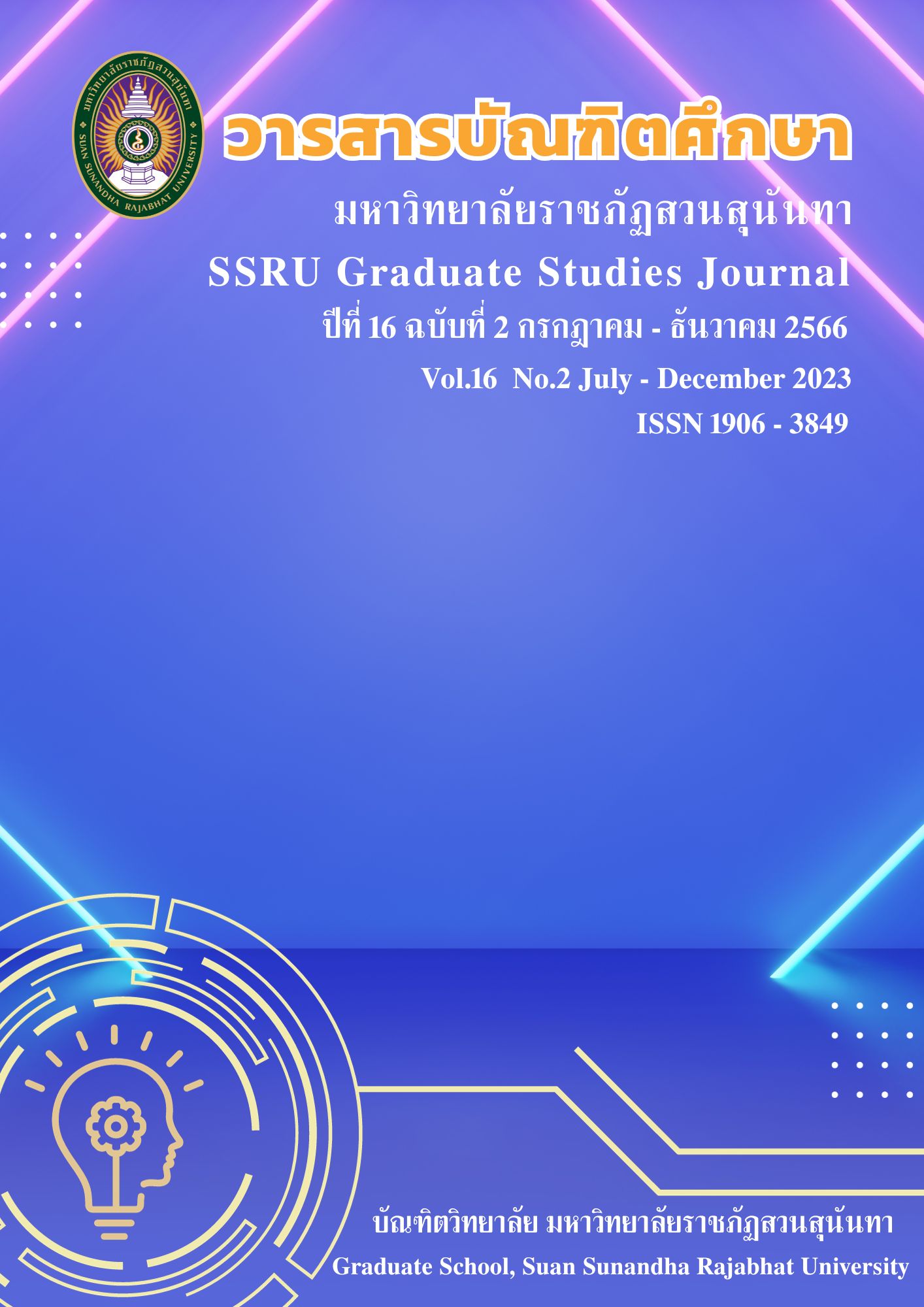กระบวนการจัดการเรียนรู้แบบร่วมมือโดยใช้กิจกรรมเป็นฐาน WPCES ร่วมกับชุดกิจกรรมทัศนศิลป์ เรื่อง ฮูปปะติดไทหล่มกับเศษวัสดุท้องถิ่นสร้างสรรค์ เพื่อเสริมสร้างสมรรถนะสำคัญของผู้เรียนชั้นประถมศึกษาปีที่ 6 โรงเรียนเทศบาลบ้านสักงอย สังกัดกองการศึกษา กระทรวงมหาดไทย
Main Article Content
บทคัดย่อ
การวิจัยครั้งนี้ มีวัตถุประสงค์ ข้อ 1 เพื่อศึกษาสภาพปัจจุบัน ปัญหาและความต้องการในการเสริมสร้างสมรรถนะสำคัญของผู้เรียน ข้อ 2 เพื่อสร้างกระบวนการจัดการเรียนรู้แบบร่วมมือโดยใช้กิจกรรมเป็นฐาน WPCES ร่วมกับชุดกิจกรรมทัศนศิลป์ ข้อ 3 เพื่อศึกษาผลการเสริมสร้างสมรรถนะสำคัญของผู้เรียนด้วยกระบวนการจัดการเรียนรู้ที่สร้างขึ้น และ ข้อ 4 เพื่อประเมินกระบวนการจัดการเรียนรู้แบบร่วมมือโดยใช้กิจกรรมเป็นฐาน WPCES ร่วมกับชุดกิจกรรมทัศนศิลป์ เรื่อง ฮูปปะติดไทหล่มกับเศษวัสดุท้องถิ่นสร้างสรรค์ เพื่อเสริมสร้างสมรรถนะสำคัญของผู้เรียนชั้นประถมศึกษาปีที่ 6 กลุ่มตัวอย่าง จำแนกตามวัตถุประสงค์การวิจัย ดังนี้ ข้อ 1 ได้แก่ ครูและผู้บริหาร ปีการศึกษา 2564 จำนวน 21 คน และผู้ปกครองและนักเรียน จำนวน 50 คน โดยการสุ่มอย่างง่าย (Simple random sampling) ข้อ 2 ผู้เชี่ยวชาญ จำนวน 15 คน ข้อ 3 นักเรียนชั้นประถมศึกษาปีที่ 6 ปีการศึกษา 2565 จำนวน 24 คน ซึ่งได้มาจากการสุ่มแบบแบ่งกลุ่ม (Cluster Sampling) ข้อ 4 นักเรียนและผู้ปกครอง ชั้นประถมศึกษาปีที่ 6 ปีการศึกษา 2565 กลุ่มละ 24 คน ซึ่งได้มาจากการสุ่มแบบแบ่งกลุ่ม (Cluster Sampling) นักเรียนและผู้ปกครองทุกคน นวัตกรรมการจัดการเรียนรู้ ประกอบด้วย แผนการจัดการเรียนรู้ เรื่อง ฮูปปะติดไทหล่มกับเศษวัสดุท้องถิ่นสร้างสรรค์ โดยใช้กระบวนการจัดการเรียนรู้แบบร่วมมือโดยใช้กิจกรรมเป็นฐาน WPCES ร่วมกับชุดกิจกรรมทัศนศิลป์เพื่อเสริมสร้างสมรรถนะสำคัญของผู้เรียนชั้นประถมศึกษาปีที่ 6 และชุดกิจกรรมทัศนศิลป์ จำนวน 6 หน่วย ได้แก่ หน่วยที่ 1 ฮูปปะติดสนุกคัก หน่วยที่ 2 ฮูปปะติดพาซิ่ง หน่วยที่ 3 ฮูปปะติดบันเทิงศิลป์ หน่วยที่ 4 ฮูปปะติดจ๊วด ๆ หน่วยที่ 5 ฮูปปะติดโฮแซว และหน่วยที่ 6 ฮูปปะติดม่วนอีหลี เครื่องมือเก็บรวบรวมข้อมูล ได้แก่ แบบประเมินสมรรถนะสำคัญของผู้เรียน แบบสัมภาษณ์ แบบสอบถาม แบบทดสอบ แบบประเมินพฤติกรรม และแบบประเมินผลชิ้นงาน วิเคราะห์ข้อมูลโดยการวิเคราะห์เนื้อหา (Content Analysis) ค่าเฉลี่ย ส่วนเบี่ยงเบนมาตรฐาน ความถี่และค่าร้อยละ และการเปรียบเทียบพัฒนาการ ผลการวิจัย พบว่า 1) ผู้มีส่วนได้ส่วนเสีย มีความต้องการให้ผู้เรียนได้รับการเสริมสร้างสมรรถนะสำคัญ โดยกระบวนการจัดการเรียนรู้ที่ให้ผู้เรียนมีส่วนร่วมในการทำกิจกรรมและมีการเรียนรู้ร่วมกัน มีการวัดและประเมินผลจากภาระงาน/ชิ้นงานที่เกิดจากการปฏิบัติกิจกรรม โดยประเด็นที่มีความต้องการมากที่สุดในการจัดการเรียนรู้ ได้แก่ ผู้เรียนสามารถผลิตชิ้นงานส่งเสริมเป็นอาชีพได้ ครูใช้กระบวนการพาคิดพาทำอย่างต่อเนื่อง ผู้เรียนสามารถออกแบบผลงานร่วมกันกับเพื่อนและมีส่วนร่วมในการเรียนรู้โดยการลงมือทำด้วยตนเอง 2) กระบวนการจัดการเรียนรู้แบบร่วมมือโดยใช้กิจกรรมเป็นฐาน WPCES ร่วมกับชุดกิจกรรมทัศนศิลป์ เรื่อง ฮูปปะติดไทหล่มกับเศษวัสดุท้องถิ่นสร้างสรรค์ เพื่อเสริมสร้างสมรรถนะสำคัญของผู้เรียนชั้นประถมศึกษาปีที่ 6 ประกอบด้วย 5 ขั้น ได้แก่ ขั้นที่ 1 ขั้นนำเข้าสู่บทเรียน W (Warm) ขั้นที่ 2 ขั้นวางแผน P (Plan) ขั้นที่ 3 ขั้นค้นหาคำตอบ C (Cooperative learning) ขั้นที่ 4 ขั้นประเมินผล (E) Evaluation และขั้นที่ 5 ผลงานผู้เรียนที่สร้างสรรค์ (S) Show โดยมีผลการประเมินความเหมาะสม (Propriety) ความถูกต้อง (Accuracy) ความเป็นไปได้ (Feasibility) และความเป็นประโยชน์ (Utility) ในภาพรวมอยู่ในระดับมากที่สุด 3) ผลการเสริมสร้างสมรรถนะสำคัญของผู้เรียนด้วยกระบวนการจัดการเรียนรู้แบบร่วมมือโดยใช้กิจกรรมเป็นฐาน WPCES ร่วมกับชุดกิจกรรมทัศนศิลป์ เรื่อง ฮูปปะติดไทหล่มกับเศษวัสดุท้องถิ่นสร้างสรรค์ พบว่า ผู้เรียนมีสมรรถนะสำคัญทุกด้าน ได้แก่ ด้านความสามารถในการสื่อสาร ความสามารถในการคิด ความสามารถในการแก้ปัญหา ความสามารถในการใช้ทักษะชีวิต และความสามารถในการใช้เทคโนโลยี อยู่ในระดับดีขึ้นไป ร้อยละ 100 4) ผลประเมินกระบวนการจัดการเรียนรู้แบบร่วมมือโดยใช้กิจกรรมเป็นฐาน WPCES ร่วมกับชุดกิจกรรมทัศนศิลป์ เรื่อง ฮูปปะติดไทหล่มกับเศษวัสดุท้องถิ่นสร้างสรรค์เพื่อเสริมสร้างสมรรถนะสำคัญของผู้เรียน ตามความคิดเห็นของผู้มีส่วนได้ส่วนเสีย พบว่า ผู้เรียนและผู้ปกครองมีความพึงพอใจในระดับมากที่สุด
Article Details

อนุญาตภายใต้เงื่อนไข Creative Commons Attribution-NonCommercial-NoDerivatives 4.0 International License.
เอกสารอ้างอิง
กระทรวงศึกษาธิการ. (2553). พระราชบัญญัติการศึกษาแห่งชาติ พ.ศ. 2542 แก้ไขเพิ่มเติม (ฉบับที่ 2) พ.ศ. 2545 และ(ฉบับที่ 3) พ.ศ.2553. สืบค้นจาก https://www.moe.go.th/backend/wp-content/uploads/2020/10/4.-พระราชบัญญัติการศึกษาแห่งชาติ-พ.ศ.2542ฉ.3.pdf
กัณฑิตา ไชยสิทธิ์ และคณะ. (2565). การพัฒนาชุดกิจกรรมการเรียนรู้โครงงานเป็นฐานร่วมกับแนวคิดการเรียนรู้แบบร่วมมือ เรื่อง วรรณกรรมท้องถิ่น สำหรับผู้เรียนชั้นมัธยมศึกษาปีที่ 3 โรงเรียนพระแสงวิทยา อำเภอพระแสง จังหวัดสุราษฎร์ธานี. วารสารมหาจุฬานาครทรรศน์ มหาวิทยาลัยมหาจุฬาลงกรณราชวิทยาลัย วิทยาเขตนครศรีธรรมราช, 9(1), 105-117.
ชัยยงค์ พรหมวงศ์. (2551). นวัตกรรมการศึกษา. กรุงเทพฯ: ธรรกมลการพิมพ์.
ทิศนา แขมมณี. (2553). ศาสตร์การสอนองค์ความรู้เพื่อการจัดกระบวนการเรียนรู้ที่มีประสิทธิภาพ. (พิมพ์ครั้งที่ 13). กรุงเทพฯ: จุฬาลงกรณ์มหาวิทยาลัย.
นนทลี พรธาดาวิทย์. (2560). การพัฒนาการจัดการเรียนรู้เชิงรุกในวิชาการจัดการเรียนรู้. วารสารวิจัย UTK ราชมงคลกรุงเทพ, 11(1), 85-94.
ปิยะนุช เถาหมอ และทวี สระน้ำคำ. (2562). ผลของบทเรียนแบบผสมผสานด้วยการเรียนแบบร่วมมือวิชาทัศนศิลป์ เพื่อส่งเสริมความคิดสร้างสรรค์สำหรับผู้เรียนชั้นประถมศึกษาปีที่ 6. e-Journal of Education Studies มหาวิทยาลัยบูรพา, 1(6), 16-29.
โรงเรียนเทศบาลบ้านสักงอย. (2561). หลักสูตรโรงเรียนเทศบาลบ้านสักงอย พุทธศักราช 2561 ตามหลักสูตรแกนกลางการศึกษาขั้นพื้นฐาน พุทธศักราช 2551 กลุ่มสาระการเรียนรู้ศิลปะ สาระทัศนศิลป์. (เอกสารอัดสำเนา).
วชิระ อุดมรัตน์. (2560). การส่งเสริมพฤติกรรมการทำงานกลุ่มโดยการจัดกิจกรรมการเรียนรู้แบบกลุ่มร่วมมือแข่งขันร่วมกับเทคนิคเกมมิฟิเคชัน สำหรับนักเรียนชันมัธยมศึกษาปีที่ 6 โรงเรียนยางตลาดวิทยาคาร. วิทยานิพนธ์ครุศาสตรมหาบัณฑิต. มหาสารคาม: มหาวิทยาลัยราชภัฏมหาสารคาม.
วัฒนาพร ระงับทุกข์. (2541). การจัดการเรียนการสอนที่เน้นผู้เรียนเป็นศูนย์กลาง. กรุงเทพฯ: เลิฟแอนด์เพรส.
วิชัย วงษ์ใหญ่. (2545). หลักสูตรและการสอน-มิติใหม่. กรุงเทพฯ: โรงพิมพ์รุ่งเรืองธรรม.
วีระ ไทยพานิช. (2551). 57 วิธีสอน. กรุงเทพฯ: ภาควิชาเทคโนโลยีทางการศึกษา คณะศึกษาศาสตร์. มหาวิทยาลัยเกษตรศาสตร์.
สมชาย รัตนะทองคำ. (2558). เอกสารประกอบการสอน 475 788 การสอนทางกายภาพบำบัด ภาคต้นปีการศึกษา 2558. เอกสารอัดสำเนา.คณะเทคนิคการแพทย์ มหาวิทยาลัยขอนแก่น: มหาวิทยาลัยขอนแก่น.
สุวิทย์ มูลคำ และอรทัย มูลคำ. (2552). 21 วิธีการจัดการเรียนรู้: เพื่อพัฒนากระบวนการคิด. (พิมพ์ครั้งที่ 8). กรุงเทพฯ: ห้างหุ้นส่วนจํากัดภาพพิมพ์.
Good. (1973). Dictionary of Education. New York. M


